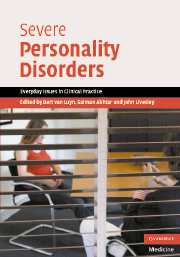Book contents
- Frontmatter
- Contents
- List of contributors
- Preface
- 1 Treatability in severe personality disorders: how far do the science and art of psychotherapy carry us?
- 2 The treatment of choice: what method fits whom?
- 3 Countertransference: recent developments and technical implications for the treatment of patients with severe personality disorders
- 4 Beyond management to cure: enhancing the positive dimensions of personality
- 5 Personality disorders from the perspective of child and adolescent psychiatry
- 6 Disruptions in the course of psychotherapy and psychoanalysis
- 7 Managing suicidal crises in patients with severe personality disorders
- 8 Borderline personality disorder, day hospitals, and mentalization
- 9 Pharmacotherapy of severe personality disorders: a critical review
- 10 Severe cases: management of the refractory borderline patient
- 11 Dangerous cases: when treatment is not an option
- 12 Stalking of therapists
- 13 Common elements of effective treatments
- Index
- References
11 - Dangerous cases: when treatment is not an option
Published online by Cambridge University Press: 14 August 2009
- Frontmatter
- Contents
- List of contributors
- Preface
- 1 Treatability in severe personality disorders: how far do the science and art of psychotherapy carry us?
- 2 The treatment of choice: what method fits whom?
- 3 Countertransference: recent developments and technical implications for the treatment of patients with severe personality disorders
- 4 Beyond management to cure: enhancing the positive dimensions of personality
- 5 Personality disorders from the perspective of child and adolescent psychiatry
- 6 Disruptions in the course of psychotherapy and psychoanalysis
- 7 Managing suicidal crises in patients with severe personality disorders
- 8 Borderline personality disorder, day hospitals, and mentalization
- 9 Pharmacotherapy of severe personality disorders: a critical review
- 10 Severe cases: management of the refractory borderline patient
- 11 Dangerous cases: when treatment is not an option
- 12 Stalking of therapists
- 13 Common elements of effective treatments
- Index
- References
Summary
There are those who walk among us that have no conscience. They mouth certain feelings, but have no emotion. They do not bond to any living creatures. Because of their chronic emotional detachment and often sadistic impulse, they aggress without inhibition when their desires are thwarted. Their sole relational goal is to dominate their objects. They are the consummate “intraspecies predators” (Meloy and Meloy, 2002).
Although this sounds like fiction, it is not. Each of these assertions is supported by abundant empirical evidence. We are describing, of course, the psychopathic subject in his most severe, ontogenetic form. Psychopathy research is burgeoning, and over the past decade the world scientific literature has yielded over a thousand studies. When psychopathy enters the consulting room, for the psychotherapist or psychoanalyst it is a sign of danger.
The nature of the beast
We theoretically conceive of psychopathy as a genotype, much like schizotypy (Raine et al., 1995) – a stable constellation of biologically predisposed traits and behaviors which exists in various members of our species. In the context of certain social and cultural norms, psychopathy has different levels of phenotypic expression. For example, best estimates suggest that psychopathy in its most severe form is present in 1% of the world's population (Hare, 2003). However, the prevalence of antisocial personality disorder (ASPD), as most recently defined in DSM-IV-TR (American Psychiatric Association, 2000), varies considerably across cultures.
- Type
- Chapter
- Information
- Severe Personality Disorders , pp. 181 - 195Publisher: Cambridge University PressPrint publication year: 2007
References
- 3
- Cited by



